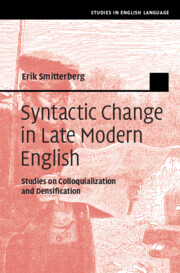Book contents
- Syntactic Change in Late Modern English
- Studies In English Language
- Syntactic Change in Late Modern English
- Copyright page
- Contents
- Figures
- Tables
- Acknowledgements
- Chapter 1 Introduction
- Chapter 2 Sociocultural and Linguistic Change in Late Modern English
- Chapter 3 Aspects of Language Change
- Chapter 4 Methodological Framework
- Chapter 5 Colloquialization I: Not-Contraction
- Chapter 6 Colloquialization II: Co-ordination by And
- Chapter 7 Densification I: Nouns as Premodifiers in Noun Phrases
- Chapter 8 Densification II: Participle Clauses as Postmodifiers in Noun Phrases
- Chapter 9 Concluding Discussion
- Appendix
- References
- Index
Chapter 7 - Densification I: Nouns as Premodifiers in Noun Phrases
Published online by Cambridge University Press: 19 November 2021
- Syntactic Change in Late Modern English
- Studies In English Language
- Syntactic Change in Late Modern English
- Copyright page
- Contents
- Figures
- Tables
- Acknowledgements
- Chapter 1 Introduction
- Chapter 2 Sociocultural and Linguistic Change in Late Modern English
- Chapter 3 Aspects of Language Change
- Chapter 4 Methodological Framework
- Chapter 5 Colloquialization I: Not-Contraction
- Chapter 6 Colloquialization II: Co-ordination by And
- Chapter 7 Densification I: Nouns as Premodifiers in Noun Phrases
- Chapter 8 Densification II: Participle Clauses as Postmodifiers in Noun Phrases
- Chapter 9 Concluding Discussion
- Appendix
- References
- Index
Summary
The increase in nouns as premodifiers in noun phrases (e.g. the stone church) is a well-known aspect of densification in Late Modern English. The corpus analysis shows that both common and proper nouns become more frequent as premodifiers. While newspapers represent the most advanced usage, the general increase in the frequency of this feature and the fact that women use it more than men in letters indicate that there may be two separate developments underway: a general increase in premodifying nouns in the communal language as a change from below and a separate trend towards additional usage as part of the densification of informational writing. Semantic analyses show that most semantic relationships between common nouns as premodifiers and their heads were already present by 1800, though some tendencies towards more opaque combinations could be found in genres where a high frequency of the feature was noted; as regards proper nouns as premodifiers, the increase in frequency was coupled with a trend towards more animate referents. Overall, the results provide clear evidence of densification in, above all, newspaper language.
- Type
- Chapter
- Information
- Syntactic Change in Late Modern EnglishStudies on Colloquialization and Densification, pp. 187 - 221Publisher: Cambridge University PressPrint publication year: 2021

